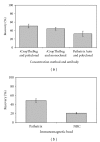Rapid Detection and Identification of Yersinia pestis from Food Using Immunomagnetic Separation and Pyrosequencing
- PMID: 23091729
- PMCID: PMC3469099
- DOI: 10.1155/2012/781652
Rapid Detection and Identification of Yersinia pestis from Food Using Immunomagnetic Separation and Pyrosequencing
Abstract
Interest has recently been renewed in the possible use of Y. pestis, the causative agent of plague, as a biological weapon by terrorists. The vulnerability of food to intentional contamination coupled with reports of humans having acquired plague through eating infected animals that were not adequately cooked or handling of meat from infected animals makes the possible use of Y. pestis in a foodborne bioterrorism attack a reality. Rapid, efficient food sample preparation and detection systems that will help overcome the problem associated with the complexity of the different matrices and also remove any ambiguity in results will enable rapid informed decisions to be made regarding contamination of food with biothreat agents. We have developed a rapid detection assay that combines the use of immunomagnetic separation and pyrosequencing in generating results for the unambiguous identification of Y. pestis from milk (0.9 CFU/mL), bagged salad (1.6 CFU/g), and processed meat (10 CFU/g). The low detection limits demonstrated in this assay provide a novel tool for the rapid detection and confirmation of Y. pestis in food without the need for enrichment. The combined use of the iCropTheBug system and pyrosequencing for efficient capture and detection of Y. pestis is novel and has potential applications in food biodefence.
Figures


Similar articles
-
Immunomagnetic capture of Bacillus anthracis spores from food.J Food Prot. 2012 Jul;75(7):1243-8. doi: 10.4315/0362-028X.JFP-12-048. J Food Prot. 2012. PMID: 22980007
-
Development of a PCR-lateral flow assay for rapid detection of Yersinia pestis, the causative agent of plague.Acta Trop. 2021 Aug;220:105958. doi: 10.1016/j.actatropica.2021.105958. Epub 2021 May 15. Acta Trop. 2021. PMID: 34004173
-
Rapid detection of Yersinia pestis recombinant fraction 1 capsular antigen.Appl Microbiol Biotechnol. 2015 Sep;99(18):7781-9. doi: 10.1007/s00253-015-6663-5. Epub 2015 May 21. Appl Microbiol Biotechnol. 2015. PMID: 25994256
-
Yersinia pestis and the plague.Am J Clin Pathol. 2003 Jun;119 Suppl:S78-85. doi: 10.1309/DQM9-3R8Q-NQWB-FYU8. Am J Clin Pathol. 2003. PMID: 12951845 Review.
-
Pneumonic Plague: The Darker Side of Yersinia pestis.Trends Microbiol. 2016 Mar;24(3):190-197. doi: 10.1016/j.tim.2015.11.008. Epub 2015 Dec 14. Trends Microbiol. 2016. PMID: 26698952 Review.
Cited by
-
Dynabeads protein G antibody conjugates combined with modified brain heart infusion broth for the enrichment and separation of Bacillus cereus in artificially contaminated vegetables.Food Sci Biotechnol. 2016 Jun 30;25(3):941-947. doi: 10.1007/s10068-016-0154-z. eCollection 2016. Food Sci Biotechnol. 2016. PMID: 30263358 Free PMC article.
References
-
- Gage KL, Kosoy MY. Natural history of plague: perspectives from more than a century of research. Annual Review of Entomology. 2005;50:505–528. - PubMed
-
- Duplantier JM, Duchemin JB, Chanteau S, Carniel E. From the recent lessons of the Malagasy foci towards a global understanding of the factors involved in plague reemergence. Veterinary Research. 2005;36(3):437–453. - PubMed
-
- Inglesby TV, Dennis DT, Henderson DA, et al. Plague as a biological weapon: medical and public health management. JAMA. 2000;283(17):2281–2290. - PubMed
LinkOut - more resources
Full Text Sources

